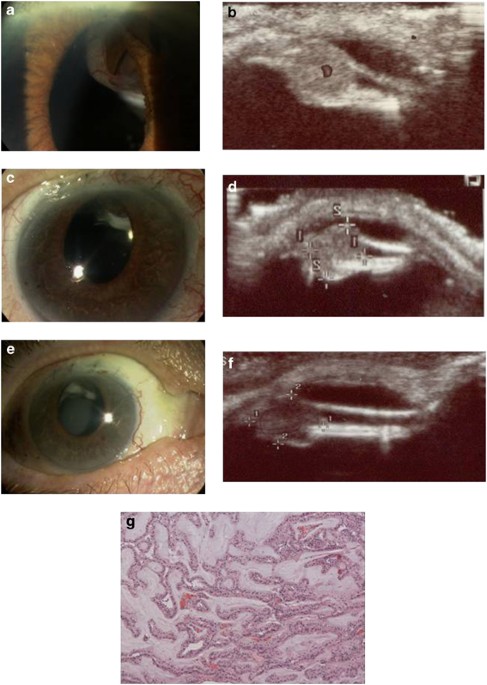
Ciliary-body adenoma of the non-pigmented epithelium with rubeosis iridis treated with plaque brachytherapy and bevacizumab
Play all audios:
Sir, Ciliary-body adenoma of the non-pigmented epithelium (NPCE adenoma) is a rare, benign tumour that can cause cataract1 and recurrent iridocyclitis,2 but, to our knowledge, has not been
reported to cause rubeosis iridis. CASE REPORT A 67-year-old male patient was referred to the Ocular Oncology Service with a ciliary body mass noted during his cataract surgery (Figures 1a
and b). An incisional biopsy was performed. Histopathology indicated the presence of eosinophilic cells in a trabecular arrangement and no mitoses (Figure 1g). Immunohistochemistry showed
positive reaction to S-100 and Melan-A but negativity for HMB-45. A diagnosis of NPCE adenoma was made. One year later, the visual acuity deteriorated to 6/12. Florid rubeosis iridis
developed with an IOP of 42 mm Hg (Figures 1c and d). Antiglaucoma medication did not reduce the intraocular pressure. Hence the patient underwent plaque brachytherapy (Ru-106) combined with
pre- and postoperative intracameral injections of bevacizumab (1.25 mg/0.05 ml). The intraocular pressure improved to 26 mm Hg and the rubeosis iridis subsided (Figures 1e and f). COMMENT
The differential diagnosis of a ciliary body mass ranges from congenital to acquired lesions, such as melanoma or leiomyoma.1 In this case the histopathology1 and immunohistochemistry3 were
consistent with the diagnosis of a NPCE adenoma.1 There is no evidence to suggest malignant transformation occurred, as there was no growth of the tumour over 1 year of follow-up. Therefore,
the presence of rubeosis iridis was attributed to the NPCE adenoma. NPCE adenoma has been shown to be associated with elevated levels of VEGF in both aqueous and vitreous humour.4 This was
the underlying cause for optic disc neovascularisation and cystoid macular oedema in one case.4 In our case, the fundus was not affected but the presumed increased VEGF production resulted
in rubeosis iridis. Plaque brachytherapy is used for the successful treatment of retinal mass lesions with neoangiogenic potential, such as vasoproliferative tumours 5 and retinal capillary
haemangiomas. Intra-cameral anti-VEGF injections are used for the management of rubeosis iridis. This combination treatment is effective in controlling the vasculogenic response of a NPCE
adenoma. REFERENCES * Shields JA, Eagle RC, Shields CL, De Potter P . Acquired neoplasm of the nonpigmented cilary epithelium (adenoma and adenocarcinoma). _Ophthalmology_ 1996; 103:
2007–2016. Article CAS Google Scholar * Bae JH, Kwon JE, Yang WI, Lee SC . Adenoma of the nonpigmented ciliary epithelium presenting with recurrent iridocyclitis: unique expression of
glial fibrillary acidic protein. _Graefes Arch Clin Exp Ophthalmol_ 2011; 249: 1747–1749. Article Google Scholar * Pecorella I, Ciocci L, Modesti M, Appolloni R . Adenoma of the non
pigmented ciliary epithelium. A rare intraocular tumor with unusual immunihistochemical findings. _Path Res Pract_ 2009; 205: 870–887. Article Google Scholar * Suzuki J, Goto H, Usui M .
Adenoma arising from nonpigmented ciliary epithelium concomitant with neovascularization of the optic disk and cystoid macular edema. _Am J Ophthalmol_ 2005; 139: 188–190. Article Google
Scholar * Cohen VM, Shields CL, Demirci H, Shields JA . Iodine I 125 plaque radiotherapy for vasoproliferative tumors of the retina in 30 eyes. _Arch Ophthalmol_ 2008; 126: 1245–1251.
Article Google Scholar Download references AUTHOR INFORMATION AUTHORS AND AFFILIATIONS * Ocular Oncology Service, Moorfields Eye Hospital, London, UK V P Papastefanou & V M L Cohen *
Ocular Oncology Service, St Bartholomew's Hospital, London, UK V P Papastefanou & V M L Cohen Authors * V P Papastefanou View author publications You can also search for this author
inPubMed Google Scholar * V M L Cohen View author publications You can also search for this author inPubMed Google Scholar CORRESPONDING AUTHORS Correspondence to V P Papastefanou or V M L
Cohen. ETHICS DECLARATIONS COMPETING INTERESTS The authors declare no conflict of interest. RIGHTS AND PERMISSIONS Reprints and permissions ABOUT THIS ARTICLE CITE THIS ARTICLE Papastefanou,
V., Cohen, V. Ciliary-body adenoma of the non-pigmented epithelium with rubeosis iridis treated with plaque brachytherapy and bevacizumab. _Eye_ 26, 1388–1390 (2012).
https://doi.org/10.1038/eye.2012.145 Download citation * Published: 20 July 2012 * Issue Date: October 2012 * DOI: https://doi.org/10.1038/eye.2012.145 SHARE THIS ARTICLE Anyone you share
the following link with will be able to read this content: Get shareable link Sorry, a shareable link is not currently available for this article. Copy to clipboard Provided by the Springer
Nature SharedIt content-sharing initiative